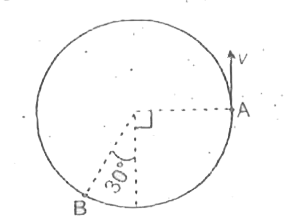A charge moves with a speed v in a circular path of radius r around a long uniformly charged conductor.
v∝r
v∝1r
v∝1√r
v∝r0
The correct Answer is:4
To solve the problem of how the velocity v of a charge moving in a circular path around a long uniformly charged conductor depends on the radius r, we can follow these steps:
1. Identify the Forces Acting on the Charge:
The charge q moving in a circular path experiences a centripetal force that is provided by the electric force due to the uniformly charged conductor.
2. Centripetal Force Equation:
The centripetal force required to keep the charge moving in a circular path is given by:
Fc=mv2r
where m is the mass of the charge and v is its speed.
3. Electric Field Due to the Charged Conductor:
The electric field E at a distance r from a long uniformly charged conductor with linear charge density λ is given by:
E=λ2πϵ0r
where ϵ0 is the permittivity of free space.
4. Electric Force on the Charge:
The electric force Fe acting on the charge q due to the electric field is:
Fe=qE=q(λ2πϵ0r)
5. Set the Forces Equal:
For circular motion, the centripetal force is provided by the electric force:
mv2r=q(λ2πϵ0r)
6. Simplify the Equation:
Multiplying both sides by r gives:
mv2=q(λ2πϵ0)
7. Solve for v2:
Rearranging the equation to isolate v2:
v2=qλ2πϵ0m
8. Conclusion about the Dependence of v on r:
Notice that in the equation for v2, there is no r term present. This indicates that the speed v does not depend on the radius r of the circular path.
9. Final Expression for v:
Taking the square root gives:
v=√qλ2πϵ0m
Thus, v is independent of r.
Final Answer:
The speed v of the charge moving in a circular path around a long uniformly charged conductor does not depend on the radius r.
The charge q moving in a circular path experiences a centripetal force that is provided by the electric force due to the uniformly charged conductor.
The centripetal force required to keep the charge moving in a circular path is given by:
Fc=mv2r
where m is the mass of the charge and v is its speed.
The electric field E at a distance r from a long uniformly charged conductor with linear charge density λ is given by:
E=λ2πϵ0r
where ϵ0 is the permittivity of free space.
The electric force Fe acting on the charge q due to the electric field is:
Fe=qE=q(λ2πϵ0r)
For circular motion, the centripetal force is provided by the electric force:
mv2r=q(λ2πϵ0r)
Multiplying both sides by r gives:
mv2=q(λ2πϵ0)
Rearranging the equation to isolate v2:
v2=qλ2πϵ0m
Notice that in the equation for v2, there is no r term present. This indicates that the speed v does not depend on the radius r of the circular path.
Taking the square root gives:
v=√qλ2πϵ0m
Thus, v is independent of r.
The speed v of the charge moving in a circular path around a long uniformly charged conductor does not depend on the radius r.
Topper's Solved these Questions
Similar Questions
A particle of mass m moves with constant speed v on a circular path of radius r. Find magnitude of average force on it in half revolution.
View SolutionA particle of mass m moves with constant speed v on a circular path of radius r as shown in figure. The average force on it during its motion from A to B is

View Solution
Knowledge Check
A particle moves with constant speed v along a circular path of radius r and completes the circle in time T. The acceleration of the particle is
A2πv/TB2πr/TC2πr2/TD2πv2/TSTATEMENT-1: It is possible for a charged particle to move in a circular path around a uniformly charged long conductor.
STATEMENT-2: The electrostatic force on the moving particle is directed towards the conductor.AStatement-1 is True, Statement-2 is True, Statement-2 is a correct explanation, for Statement-1.BStatement-1 is True, Statement-2 is True, Statement-2 is not a correct explanation for Statement-1.CStatement-1 is True, Statement-2 is False.DStatement-1 is a False, Statement-2 is True.An electron of charge e is moving in a circular orbit of radius r around a nucleus, at a frequency v. The magnetic moment associated with the orbital motion of the electron is
A2πver2Bπvr22Cπevr2Dπvr24
A positive charge Q is fixed at a point in space. There is another charge -q, which moves in a circular path of radius r around the given fixed charge . Assume that the electrostatic force between them is the only force acting on them. Calculate time period of revolution of charge .
View SolutionIf a charged particle having charge q is moving in a circular path of radius R with a uniform speed u, what would be the magnetic field at the centre?
View SolutionWhen an electron moves in a circular path around a stationay nucles charge at the center
View SolutionAn electron of charge e and mas m is moving in a circular path of radius r with a unifrom angular speed ω . Then which of the following statementa are correct?
View SolutionA particle of charge −q and mass m moves in a circle of radius r around an infinitely long line charge of linear charge density +λ. Then, time period will be
 where , k=14πε0)
where , k=14πε0)
View Solution

